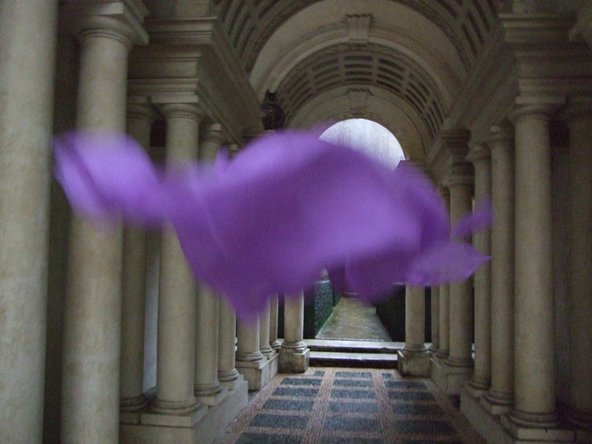Professor Martin Kemp FBA writes about Liz Rideal’s Dancing with Borromini, Palazzo Spada (cat) which is on display above the staircase in No. 11.
Drapery occupies a greater amount of space in European religious paintings and sculptures than any other single feature, with the possible exception of the sky. Yet we take it for granted. Any painter would have known that its role is crucial if the work of art is to exercise its full effect. The nature of the cloth in a painting - coarse or soft, opaque or diaphanous, shiny or rough, colourful or dull, simple or sumptuous, folded or flat, still or moving, concealing or disclosing - carries essential information about the status of the participants, their poses, their motions and more generally about how they perform their devotional and narrative roles according to the principles of decorum.

Drapery occupies a greater amount of space in European religious paintings and sculptures than any other single feature, with the possible exception of the sky. Yet we take it for granted. Any painter would have known that its role is crucial if the work of art is to exercise its full effect. The nature of the cloth in a painting - coarse or soft, opaque or diaphanous, shiny or rough, colourful or dull, simple or sumptuous, folded or flat, still or moving, concealing or disclosing - carries essential information about the status of the participants, their poses, their motions and more generally about how they perform their devotional and narrative roles according to the principles of decorum.
Leonardo da Vinci formulated the kind of rule that all good artists obeyed, without necessarily sharing his classificatory obsessions.
'If you wish to make woollen cloth, use folds appropriate to that, and should it be silk or fine cloth or rude cloth or linen or voile, differentiate the folds for each type... Some draperies will have soft folds and their sides will not be angular but curved - and this occurs with silks and satins and other thin cloths, like linen and voile and suchlike. Also make some draperies with a few large folds as with coarse cloth, like that seen in felt.'
Of the many types of fabric, sensuously thin veils of muslin and silk (including chiffon and organza) have played especially effective roles. The Mona Lisa is a case in point, where the normal Florentine costume has been overlaid by a symphony of veils within the context of what I have called his 'optics of uncertainty'. The Virgin is shown by Raphael and others drawing back a diaphanous veil to let us see Christ with privileged clarity. Sometimes His genitals are veiled in such way as not wholly to conceal the most evident testament to His taking on human flesh. Veiled headdresses have adorned saints and sinners alike. 'Wet look' diaphanous drapes on female bodies paid titillating homage to the statuary of ancient Rome. Veils also provided a conspicuous way for painters (and even sculptors) to demonstrate their technical virtuosity.
Liz Rideal has undertaken a sustained series of photographic works that centre on the neglected eloquence of cloths, particularly floating silks. The Academy's Dancing with Borromini, Palazzo Spada (cat) is one of a series, undertaken whilst at the British School at Rome during 2008-2009, in creative dialogue with the extraordinary architecture of Francesco Borromini. His intricate drawings rely upon a fretwork of dynamic geometry that translates in his buildings into spatial fluidity rather than the regular proportionality of Renaissance architecture (with the notable exception of Michelangelo). In Rideal's own words, she wanted to
'experience the spaces of Borromini in the city, and to animate them with my drapery, using it to highlight the spatial ambiguities of his architecture, to complete the circle, to stand at the point where the spectator is implied. Borromini’s restrained decoration, unique interpretation of architectural language, and his mathematic logic become the perfect foil for the subtleties of the ephemeral, richly coloured transparent silks, that billow and twist with sublimated sexual energy. The gauze veils and reveals details of his buildings, and tantalisingly implies the human presence, evoking fleeting figures and a variety of emotional states. The chaotic movement of the drapery contrasts with the deliberate grace of Borromini’s details, while the rich colour complements his white spaces.'
She was particularly taken by the architectural illusion at the Palazzo Spada, in which Borromini and the Augustinian mathematician Fra Giovanni Maria Bitonti exploited accelerated perspective as an illusion to extend the corridor and garden to about three times its actual depth. Against the apparent space, Rideal's silken veil floats, twists and descends in a way that is unpredictably chaotic (but not random), constrained by the parameters of its own material properties in concert with the resistant air. Lying over the 'vanishing point', her veil masks the finite termination of the garden. The axial architecture in Rideal's photograph is tilted and asymmetrical, adding a subtle dimension of visual instability. Her veil, a little out of focus, exists as an intangible and spiritual presence in an architecture whose own mass is illusionary. Only later did she notice an observing cat perched on the cornice in the upper left, more cognisant of real dimensions than optical illusions. Appropriately, Borromini's patron, Cardinal Bernardino Spada, composed an epigram that reminded all visitors that 'worldly grandeur is nothing but an illusion'.

The resonances of the photograph with Baroque Rome are legion. We may think of the billowing cloaks and fluttering dresses of airborne saints in illusionistic vaults. Heaven is as full of draperies as here on earth. We may recall the crescendo of animated folds in Bernini's St Theresa as the angel repeatedly thrusts her golden arrow into the Saint's ecstatic breast. In the Galleria Borghese, Bernini's image of naked Truth is comprehensively unveiled by time. We may remember Dante's definition of allegory as hiding truth behind a cloak (manto). Rideal's photograph is seductively inviting us to collaborate with old artistry in a new way.